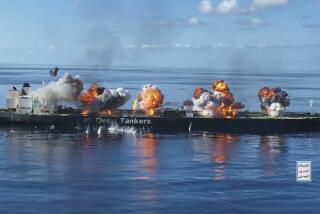Lloyd’s Imposes 50% Boost in Insurance Premiums : 2 More Ships Hit; Another Convoy Sails
- Share via
DUBAI, United Arab Emirates — A convoy of Kuwaiti oil tankers guarded by American warships left Kuwait early Thursday bound for the Gulf of Oman, and two more civilian ships were reported attacked in the Persian Gulf.
The fresh attacks--on an Italian freighter raked by gunfire from Iranian speedboats and on a vessel of unknown nationality hit by Iraqi warplanes--came a day after civilian shipping fell under the heaviest attack in the seven-year-old Iran-Iraq War, with nine vessels hit.
Two deaths, the first reported since the so-called tanker war between the two foes flared up again over the weekend after a 45-day lull, were confirmed in the Wednesday sinking of a small supply ship by Iraqi jets near Iran’s Kharg Island oil terminal. The vessel, the Panamanian-registered Big Orange XIV, operated out of the United Arab Emirates.
Insurance Rates Hiked
In London, meanwhile, Lloyd’s Underwriters Assn. put into effect a 50% increase in war risk insurance premiums for ships that ply the gulf.
The three Kuwaiti tankers and their two U.S. escorts--the seventh one-way convoy since the United States began re-registering Kuwaiti tankers to fly the American flag July 20--were reported passing Iranian-held Farsi Island late Thursday afternoon. The island is believed to be a major base for Iranian Revolutionary Guards whose speedboats have mounted attacks on ships of nations allied with Iraq.
As the convoy proceeded on its two-day journey toward the Strait of Hormuz and beyond, Western and Arab diplomats were saying that the recent surge in attacks on maritime targets by Iraq and Iran appears to have increased the chances that the United States will be drawn directly into the conflict.
Since the weekend, Iraqi warplanes are reported to have hit 12 ships in the gulf, most of them Iranian, and Revolutionary Guard speedboats, carrying rockets and machine guns, have reportedly struck nine ships of various nationalities.
Indiscriminate Attacks
An Iranian attack late Wednesday on a Japanese tanker, the 180,000-ton Nisshin Maru, which was carrying Iranian oil at the time, suggests that the forays by the Revolutionary Guards are intentionally indiscriminate, according to the diplomats.
“The danger of somebody pushing the button a bit prematurely must certainly be greater than last week by a factor of 10,” said one diplomat. “Neither Iran nor the United States really wants a fight, but the possibility of an accidental flare-up is much greater than ever before.”
The diplomats wondered whether the U.S. Navy would be able to remain aloof if neutral shipping comes under attack by Iranian gunboats while a Kuwaiti convoy under American guard is nearby. What would be Iran’s response if the U.S. ships sank a gunboat?
The United States has maintained that its presence in the gulf is designed only to preserve freedom of navigation in the waterway.
U.S. Force Doubled
The Navy has doubled its Mideast Force in gulf waters to 10 ships, including the helicopter carrier Guadalcanal, which has given the naval force a mine-hunting capability. Outside the gulf are 20 more warships, including an aircraft carrier and the battleship Missouri.
Meanwhile, the United States has replaced Iraq in Iran’s propaganda as the principal culprit in the current fighting, increasing the current level of tension between Washington and Tehran.
The Iranians have bitterly attacked the United States for threatening to lead a campaign to impose an arms embargo against Iran unless the Iranian government accepts a U.N. cease-fire resolution that was adopted July 20. Iraq has indicated that it would accept the resolution.
Iranian Prime Minister Hussein Moussavi asserted, for example, that Iraqi air attacks were part of a “vain bid to impose a U.S.-sponsored peace on Iran and will end in failure.”
Iraq Resumes Attacks
In an effort to force the Iranians to accept the truce, which also includes a withdrawal from occupied territory, Iraq resumed its air war against Iran’s oil exports last Saturday. In addition to hitting Iranian vessels, Iraqi warplanes have struck oil fields plus pumping stations and other offshore targets.
As expressed by Iraqi President Saddam Hussein, Baghdad’s goal is to sever Iran’s “economic arteries.”
While threatening Iran with an arms embargo, the diplomats noted, the United States has only mildly reproached Iraq for resuming the tanker war, bolstering Iran’s perception of an American “tilt” toward Iraq.
Iran has a small fleet of oil tankers, estimated at between 12 and 18 ships, which are used to ferry oil from the Kharg Island terminal in the upper gulf to Sirri and Larak islands in the south. There the oil is transferred to foreign tankers.
Oil Output Threatened
Thus, if Iraq has succeeded in seriously damaging a large number of these ships, Iran’s oil output could be sharply curtailed. In recent weeks, that total has been more than 2 million barrels a day.
Diplomats said they are concerned that the U.S. demand that Iran accept a cease-fire or face an arms embargo may have the opposite of the intended effect, with Iran keeping up the fight to show the world that it can stand up to the United States.
The effect of an arms embargo is regarded as negligible since Iran already purchases its arms on the black market and from such countries as North Korea.
More to Read
Sign up for Essential California
The most important California stories and recommendations in your inbox every morning.
You may occasionally receive promotional content from the Los Angeles Times.










